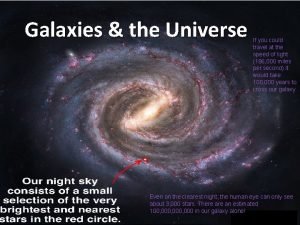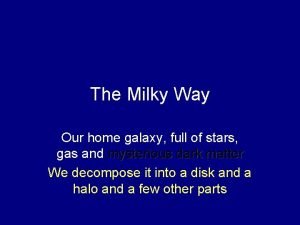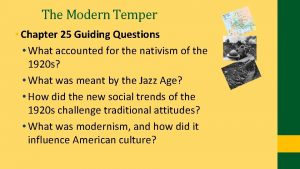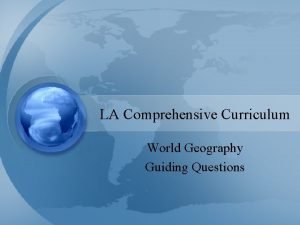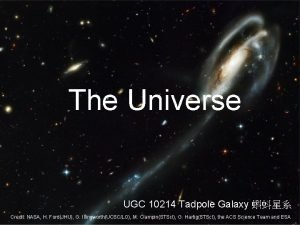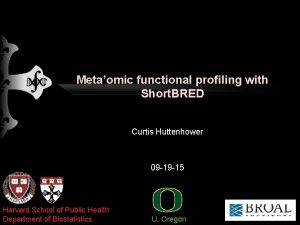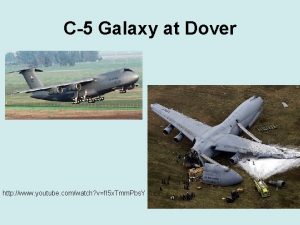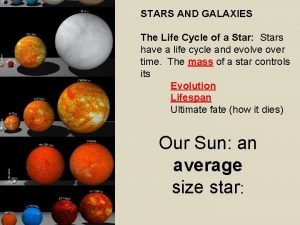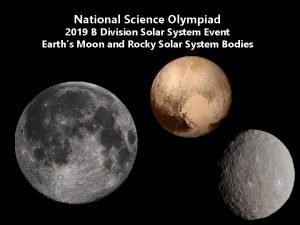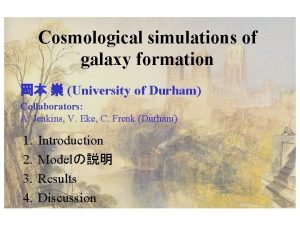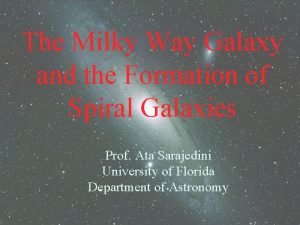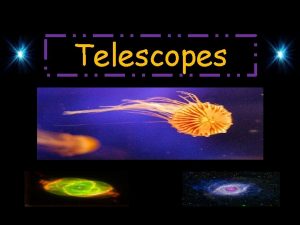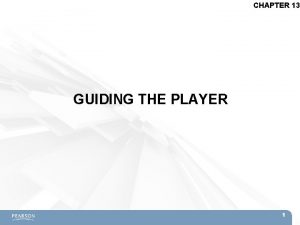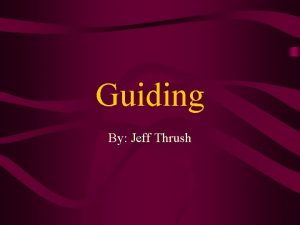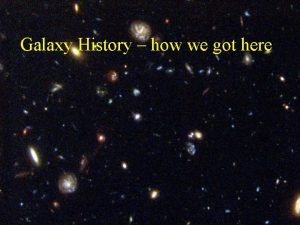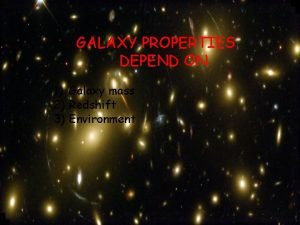Our Galaxy Chapter TwentyFive Guiding Questions 1 What








































- Slides: 40

Our Galaxy Chapter Twenty-Five

Guiding Questions 1. What is our Galaxy? How do astronomers know where we are located within it? 2. What is the shape and size of our Galaxy? 3. How do we know that our Galaxy has spiral arms? 4. What is most of the Galaxy made of? Is it stars, gas, dust, or something else? 5. What is the nature of the spiral arms? 6. What lies at the very center of our Galaxy?

Interstellar dust obscures our view at visible wavelengths along lines of sight that lie in the plane of the galactic disk

As a result, the Sun’s location in the Galaxy was unknown for many years

This dilemma was resolved by observing parts of the Galaxy outside the disk



Determining the distance and direction of the globular clusters gave us the Sun’s location Our Sun lies within the galactic disk, some 8000 pc (26, 000 ly) from the center of the Galaxy

Observations at nonvisible wavelengths reveal the shape of the Galaxy

There about 200 billion (2 × 1011) stars in the Galaxy • Our Galaxy has a disk about 50 kpc (160, 000 ly) in diameter and about 600 pc (2000 ly) thick, with a high concentration of interstellar dust and gas in the disk • The Sun orbits around the center of the Galaxy at a speed of about 790, 000 km/h • It takes about 220 million years to complete one orbit

• The galactic center is surrounded by a large distribution of stars called the central bulge • This bulge is not perfectly symmetrical, but may have a bar or peanut shape • The disk of the Galaxy is surrounded by a spherical distribution of globular clusters and old stars, called the galactic halo

The spin-flip transition in hydrogen emits 21 -cm radio waves

• This is the same physical principle behind magnetic resonance imaging (MRI), an important diagnostic tool of modern medicine

These emissions easily penetrate the intervening interstellar dust

Spiral arms can be traced from the positions of clouds of atomic hydrogen


OB associations, H II regions, and molecular clouds in the galactic disk outline huge spiral arms




The rotation of our Galaxy reveals the presence of dark matter From studies of the rotation of the Galaxy, astronomers estimate that the total mass of the Galaxy is about 1012 M





Only about 10% of this mass is in the form of visible stars, gas, and dust • The remaining 90% is in some nonvisible form, called dark matter, that extends beyond the edge of the luminous material in the Galaxy • Our Galaxy’s dark matter may be a combination of MACHOs (dim, star-sized objects), massive neutrinos, and WIMPs (relatively massive subatomic particles)

Spiral arms are caused by density waves that sweep around the Galaxy • There are two leading theories of spiral structure in galaxies • According to the densitywave theory, spiral arms are created by density waves that sweep around the Galaxy • The gravitational field of this spiral pattern compresses the interstellar clouds through which it passes, thereby triggering the formation of the OB associations and H II regions that illuminate the spiral arms






• According to theory of self-propagating star formation, spiral arms are caused by the birth of stars over an extended region in a galaxy • Differential rotation of the galaxy stretches the starforming region into an elongated arch of stars and nebulae.



The innermost part of the Galaxy, or galactic nucleus, has been studied through its radio, infrared, and X-ray emissions (which are able to pass through interstellar dust)



A strong radio source called Sagittarius A* is located at the galactic center This marks the position of a supermassive black hole with a mass of about 3. 7 × 106 M

Key Words • • • • central bulge (of a galaxy) dark matter density wave disk (of a galaxy) far-infrared flocculent spiral galaxy galactic nucleus galaxy globular cluster grand-design spiral galaxy HI halo (of a galaxy) high-velocity star interstellar extinction Local Bubble • • • • magnetic resonance imaging (MRI) massive compact halo object (MACHO) microlensing Milky Way Galaxy near-infrared rotation curve RR Lyrae variable Sagittarius A* self-propagating star formation spin (of a particle) spin-flip transition spiral arm 21 -cm radio emission weakly interacting massive particle (WIMP) winding dilemma
 Elliptical, spiral and irregular.
Elliptical, spiral and irregular. Are the stars we see at night in our galaxy
Are the stars we see at night in our galaxy Our home galaxy
Our home galaxy Our home galaxy
Our home galaxy Galaxy questions
Galaxy questions Guiding questions for geography
Guiding questions for geography Guiding questions iron curtain speech
Guiding questions iron curtain speech What does bias through selection and omission mean
What does bias through selection and omission mean Guiding storytelling experiences
Guiding storytelling experiences Our moral life in christ chapter 9 study questions
Our moral life in christ chapter 9 study questions Our moral life in christ chapter 5 study questions
Our moral life in christ chapter 5 study questions Our moral life in christ chapter 3 study questions
Our moral life in christ chapter 3 study questions Our moral life in christ chapter 2 study questions
Our moral life in christ chapter 2 study questions Thinking affects our language which then affects our
Thinking affects our language which then affects our Our census our future
Our census our future Christ be our light bernadette farrell
Christ be our light bernadette farrell Marcus aurelius our life is what our thoughts make it
Marcus aurelius our life is what our thoughts make it We bow our hearts
We bow our hearts Our census our future
Our census our future Our life is what our thoughts make it
Our life is what our thoughts make it Theme of the poem money madness
Theme of the poem money madness Awareness of ourselves and our environment is:
Awareness of ourselves and our environment is: Awareness of ourselves and our environment
Awareness of ourselves and our environment God our father christ our brother
God our father christ our brother Our future is in our hands quotes
Our future is in our hands quotes Our awareness of ourselves and our environment.
Our awareness of ourselves and our environment. Is our awareness of ourselves and our environment.
Is our awareness of ourselves and our environment. Ngc 6822
Ngc 6822 Lefse huttenhower
Lefse huttenhower Galazy.einet
Galazy.einet Galaxy einet
Galaxy einet Youtube
Youtube Disc filters galaxy 4 spin klin series
Disc filters galaxy 4 spin klin series Galaxy definition
Galaxy definition Life cycle of a galaxy
Life cycle of a galaxy Solar system science olympiad
Solar system science olympiad Galaxy control systems
Galaxy control systems Classification
Classification Galaxy formation
Galaxy formation Virtual galaxy
Virtual galaxy Canis major dwarf galaxy
Canis major dwarf galaxy

